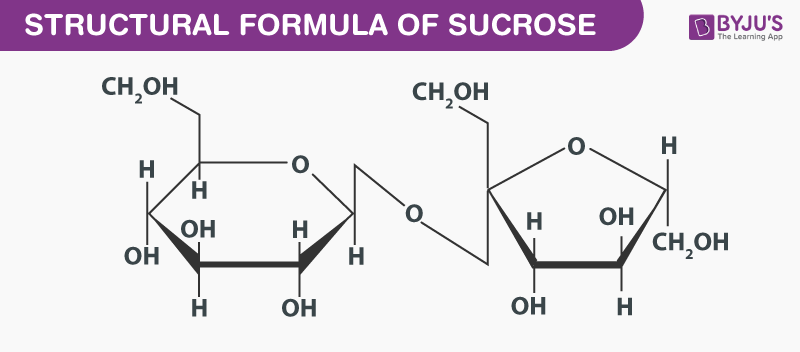Sugar formula, for table sugar which is also known as sucrose formula, is given in this article. Sucrose is a disaccharide. It consists of two monosaccharide molecules viz fructose and glucose. The chemical or molecular formula for sucrose is C12H22O11. Each sugar molecule has 12 carbon atoms, 11 oxygen atoms, and 22 hydrogen atoms.
It is a white solid, odourless and has a sweet taste. This non-reducing disaccharide compound is highly soluble in water and methanol. It does not dissolve in ethyl ether but is slightly soluble in ethanol. It can be obtained from sugarcane, beta vulgaris, and various other plants. It is widely used in food as a sweetener.
Structural Formula Of Sucrose (Table Sugar)


Properties Of Sucrose (Table Sugar)
| Chemical formula | C12H22O11 |
| Molecular weight | 342.30 g/mol |
| Density | 1.587 g/cm3 |
| Melting point | Decomposes at 186 °C |
Sugar formula for various other sugars:
Some sugars have the same chemical formula and so it might not be a good idea to distinguish them on basis of it. They can be differentiated based on the structure, location, and type of chemical bonds between them.
| Sugar name | Chemical formula |
| Arabinose | C5H10O5 |
| Galactose | C6H12O6 |
| Lactose | C12H22O11 |
| Mannose | C6H12O6 |
| Trehalose | C12H22O11 |
| Fructose | C6H12O6 |
| Glucose | C6H12O6 |
| Inositol | C6H12O6 |
| Ribose | C5H10O5 |
| Xylose | C5H10O5 |
Frequently Asked Questions
Does sugar have a chemical formula?
For a sugar known as sucrose, table sugar is the generic name. It is a type of disaccharide formed from a combination of glucose and fructose monosaccharides. C12H22O11 is the chemical or molecular formula for sucrose, meaning each sugar molecule contains 12 atoms of carbon, 22 atoms of hydrogen and 11 atoms of oxygen.
What are the 3 elements in the formula for sugar?
Therefore, all carbohydrates, including sugar, contain the same three elements: carbon, oxygen and hydrogen. To make different types of carbohydrates, different arrangements of these elements form single units. For instance, glucose is a single-unit with six atoms of carbon, 12 atoms of hydrogen and six atoms of oxygen.
What is the common name of sugar?
Sucrose is the sugar form that is the most popular. Sometimes named “table sugar,” it is a carbohydrate present in many fruits and plants that occurs naturally. Usually, table sugar is derived from sugar cane or sugar beets. It consists of 50 percent glucose, bound together, and 50 percent fructose.
What is meant by crystallization?
Crystallization is the mechanism by which solid forms are arranged into a structure known as a crystal, where the atoms or molecules are highly organized. Any of the forms in which crystals form are directly from a gas precipitating, freezing, or more rarely deposited from a solution.
What is the difference between glucose and fructose?
Glucose and fructose are absorbed into your bloodstream immediately, while it is important to break down sucrose first. For energy, glucose is used or stored as glycogen. Fructose is converted or processed as fat into glucose.
To learn more about such chemistry topics register to BYJU’S now!
Comments